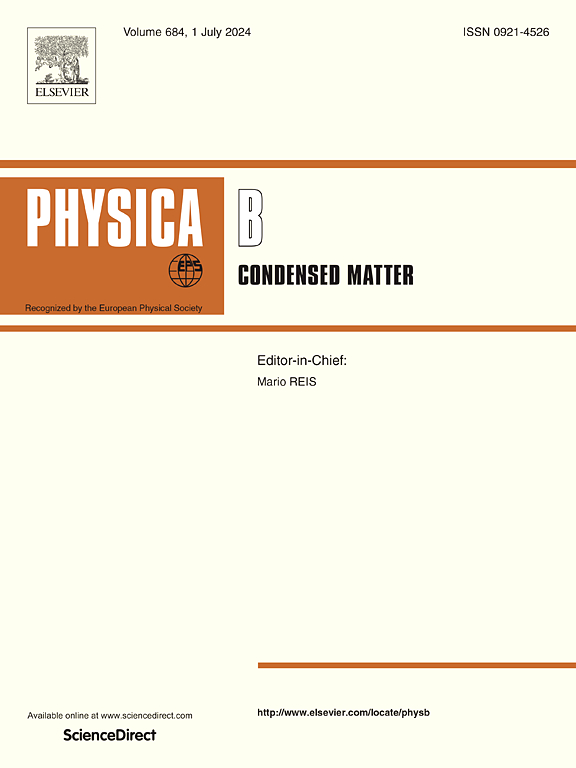Improved ultraviolet photodetection and oxygen gas sensing performance using CeO2 rare-earth oxide thin films deposited on GaN
IF 2.8
3区 物理与天体物理
Q2 PHYSICS, CONDENSED MATTER
引用次数: 0
Abstract
In recent years, high-k dielectric oxide-based metal-insulator-semiconductor (MIS) heterojunctions gain increasing attention due to their potential for dual functionality in ultraviolet (UV) photodetectors (PDs) and gas sensors, offering promising applications in next-generation optoelectronic and sensing technologies. This work presents the fabrication and performance of a vertical Au/CeO2/GaN heterojunction device for both UV photodetection and oxygen sensing applications. Grazing incidence X-ray diffraction (GIXRD) confirms the formation of cubic-phase CeO2, while field emission scanning electron microscopy (FESEM) reveals a uniform distribution of CeO2 clusters on the GaN substrate, indicating a well-developed surface morphology. X-ray photoelectron spectroscopy (XPS) verifies the elemental composition and chemical states of Ce3+ and O2−. The photodetection properties are evaluated through I-V (dark and UV-illuminated), external quantum efficiency (EQE), detectivity (D∗), responsivity and time-resolved (I-t) measurements. Under 365 nm illumination at 3 V bias, the Au/CeO2/GaN device post-annealed at 500 °C exhibits a responsivity of 13 A/W, an EQE ranging from 4.8 × 102 to 1.1 × 103 % and a D∗ of 1.4 × 1014 Jones. Time-resolved measurements at 0 V show a response time of 80 ms and a recovery time of 480 ms for the 500 °C post-annealed device. For gas sensing, the same heterojunction undergoes exposure to 100 % O2, 100 % CO2, 1000 ppm NO and 500 ppm SO2. The 500 °C post-annealed device demonstrates enhanced sensitivity to oxygen with response values of 0.47, 0.72, 0.77 and 0.82 for 25 %, 50 %, 75 % and 100 % O2 concentrations, respectively. Time-dependent measurements under 3 V bias yield a response time of 40 s and a recovery time of 47 s. These results confirm the effectiveness of the cost-efficient conventional e-beam evaporation method in producing high-performance CeO2-based Au/CeO2/GaN heterojunctions, highlighting their potential for integrated UV photodetection and oxygen gas sensing applications.
在氮化镓上沉积CeO2稀土氧化物薄膜,提高了其紫外光探测和氧气感测性能
近年来,高k介电氧化物基金属-绝缘体-半导体(MIS)异质结由于其在紫外(UV)光电探测器(pd)和气体传感器中的双重功能潜力而受到越来越多的关注,在下一代光电和传感技术中提供了有前途的应用。这项工作介绍了一种垂直Au/CeO2/GaN异质结器件的制造和性能,用于紫外光探测和氧传感应用。掠入射x射线衍射(GIXRD)证实了三相CeO2的形成,而场发射扫描电镜(FESEM)显示了CeO2簇在GaN衬底上的均匀分布,表明表面形貌发育良好。x射线光电子能谱(XPS)验证了Ce3+和O2−的元素组成和化学状态。通过I-V(暗和紫外光照射)、外量子效率(EQE)、探测性(D∗)、响应性和时间分辨(I-t)测量来评估光探测特性。在3v偏置365nm下,经过500℃退火的Au/CeO2/GaN器件的响应率为13a /W, EQE为4.8 × 102 ~ 1.1 × 103%, D *为1.4 × 1014 Jones。时间分辨测量在0 V显示响应时间为80 ms,恢复时间为480 ms的500°C后退火器件。对于气体传感,相同的异质结经历暴露于100% O2, 100% CO2, 1000 ppm NO和500 ppm SO2。500°C退火后的器件对氧气的灵敏度增强,对25%、50%、75%和100% O2浓度的响应值分别为0.47、0.72、0.77和0.82。在3 V偏置下的时间依赖性测量产生的响应时间为40秒,恢复时间为47秒。这些结果证实了成本效益高的传统电子束蒸发方法在生产高性能基于CeO2的Au/CeO2/GaN异质结方面的有效性,突出了它们在集成紫外光探测和氧气传感应用方面的潜力。
本文章由计算机程序翻译,如有差异,请以英文原文为准。
求助全文
约1分钟内获得全文
求助全文
来源期刊

Physica B-condensed Matter
物理-物理:凝聚态物理
CiteScore
4.90
自引率
7.10%
发文量
703
审稿时长
44 days
期刊介绍:
Physica B: Condensed Matter comprises all condensed matter and material physics that involve theoretical, computational and experimental work.
Papers should contain further developments and a proper discussion on the physics of experimental or theoretical results in one of the following areas:
-Magnetism
-Materials physics
-Nanostructures and nanomaterials
-Optics and optical materials
-Quantum materials
-Semiconductors
-Strongly correlated systems
-Superconductivity
-Surfaces and interfaces
 求助内容:
求助内容: 应助结果提醒方式:
应助结果提醒方式:


